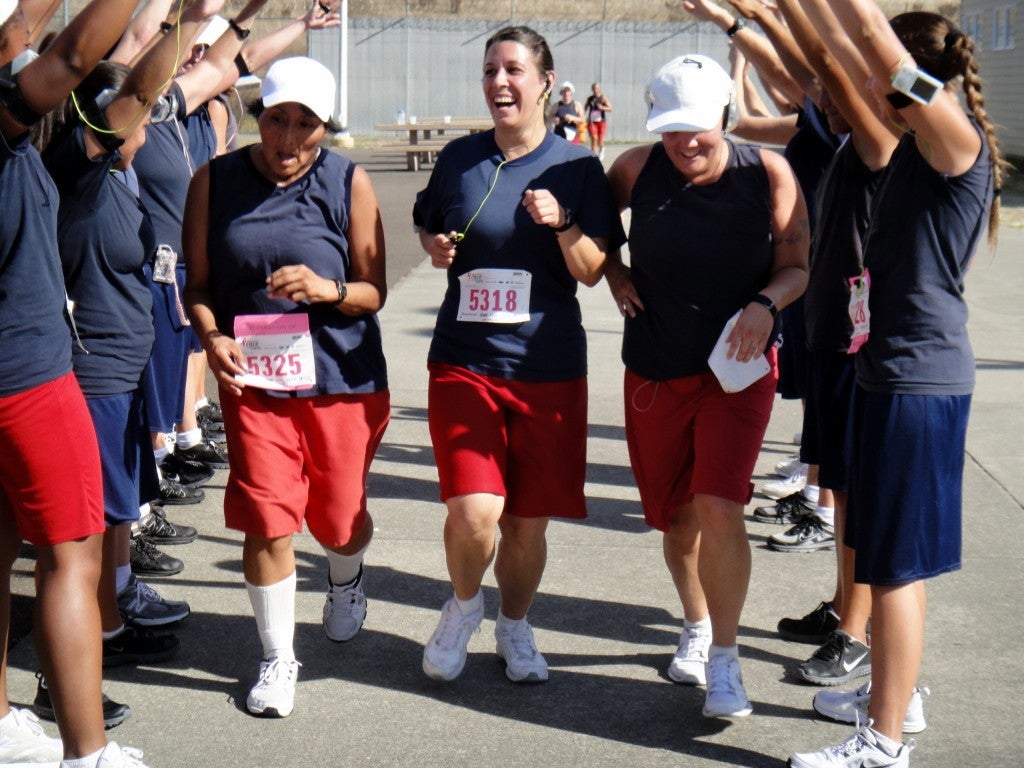Bunk To 5K—The Program That Gets Prison Inmates Running

Photo: Courtesy of Trisha Swanson
Trisha Swanson, a 45-year-old mother of two, has run eight ultramarathons and more than 10 marathons. Yet, she hasn’t forgotten the sense of accomplishment she felt 20 years ago when she finished her first 5K, which inspired her to become a running coach.
One of her greatest passions is helping other women—especially those in prison—experience the benefits of running.
In 2007, Swanson began volunteering at the Coffee Creek Correctional Facility (CCCF), a women’s prison in Wilsonville, Ore., where she assisted with weekly church services for the inmates. During the course of her ministry, the inmates discovered she was a runner and told her that they wanted to do some running too.
In 2011 with support from the CCCF administration, Swanson partnered with Susan G. Komen Race for the Cure and created the prison’s first annual 5K Race for the Cure Inside. Three years later, the administration approached Swanson with a request—the inmates wanted a year-round running program in addition to the race.
“I was super excited about it because I know what running can do for you,” Swanson says.
She was a fan of the popular Couch to 5K program, which aims to gradually move people from sedentary to active lifestyles, but there were no couches in prison. So she dubbed her program Bunk to 5K and designed it to not only help the women learn to run, but to also build friendships.
Tiffany Murphy, a 32-year-old mother of two from Salem, Ore., was one of those women. When she entered CCCF in Sept. 2014, she was overweight and had knee problems now and then. She never thought she had the strength to run until she signed up for the running group.
“One of my bunk mates told me how much she enjoyed it and how much weight she had lost, so I decided to give it a try,” Murphy says.
Turns out, she could run and loved the mental escape it provided, even on a tiny track surrounded by razor wire fencing. Nine laps was about a mile.
Related: 5 Tips To Successfully Run A 5K With Kids In Tow
“We ran in a circle over and over again, but it was a chance to be whoever we wanted and accomplish whatever we needed to,” Murphy says.
During the twice-a-week training sessions, Murphy and her running mates worked up to running for 50 minutes over a period of eight weeks. The sessions also included dynamic stretching, strength exercises, and discussions about nutrition, injury prevention, and stress relief. Additionally, Swanson created weekly training plans for the girls to follow on their own. At the end of the training cycle, the ladies pinned on race bibs and ran 28 laps around the prison yard.
“I didn’t feel alone anymore when I realized that I had women running right beside me who wanted to see me succeed as much as I wanted to see them succeed,” Murphy says of her first 5K. That success motivated her to sign up for the Stomp Out Abuse 10K, another race Swanson organized inside the prison by partnering with Abuse Recovery Ministry & Services (ARMS).
“Running 6.2 miles was a zenith for me,” Murphy says. “I felt like if I can do this, there’s very little in my life after my release that I won’t be able to tackle.”
Related: Scientists May Have Pinpointed the Reason for ‘Runner’s High’
When she got out of prison in Sept. 2015—80 pounds lighter than when she went in—one of the first things she did was run, but initially, it was kind of scary, she says.
“I felt like I should be running in circles,” Murphy explains. “Prison was the only place I’d ever run, but I created new paths.”
One of those paths meandered through the gorgeous mountain town of Bend, Ore., where in April 2016, she finished her first half marathon—another milestone along her journey of recovery. Running, she says, has helped to free her from the clutches of alcohol addiction, which she struggled with for years.
“After a run, I come home sweaty and sore, but I’d rather be sore from the workout than hungover from the party,” Murphy says. “There’s a lot to be said for the cleansing properties of sweat. In prison, I sweated out a lot of my weakness, insecurity, self-imposed inequity and self-loathing.”
Swanson’s running program at CCCF has evolved into a nonprofit, Reason to Run, which has now trained more than 150 inmates and provided over 30 post-release run care packages that include running shoes, a jog bra, and socks. In May 2016, Swanson received the 2016 Outstanding Volunteer Award from the Oregon Department of Corrections.
“What Trisha is doing is saving lives,” Murphy says. “There’s a lot of ugliness, tension, and suffering in the prison, but at the same time there’s a lot of healing. Trisha is giving women who felt like they had no hope something that’s bigger than themselves.”
Learn more at www.reasontorun.com.
Cate Hotchkiss is a freelance writer, marathoner, and mom who lives in Hood River, Ore. She blogs at gorgegirlruns.blogspot.com.